बवासीर को हेमरॉइड्स के रूप में भी जाना जाता है, ये गुदा नहर वाले हिस्से में सूजी हुई नसें हैं। अपनी सामान्य अवस्था में, वे मल के मार्ग को नियंत्रित करने के लिए आरामदायक गद्दे की तरह से काम करती हैं। हालांकि बवासीर का सही कारण मालूम नहीं है, लेकिन अध्ययनों से पता चला है कि बवासीर के लिए बहुत हद तक जिम्मेदार वे कारक होते हैं जो मल त्यागने के दौरान गुदा वाले हिस्से में दबाव बढ़ाते हैं।
बैठते या मल त्याग करते समय गुदा वाले हिस्से में जलन जैसे लक्षणों से पीड़ित व्यक्ति को समस्या की पहचान कराने के लिए डॉक्टर से परामर्श लेना चाहिए। डॉक्टर द्वारा बताए गए उपचार का पालन करें। डॉक्टर की लिखी दवाओं या सर्जरी के साथ-साथ, आपको एक स्वस्थ जीवन शैली और आहार का पालन करने के लिए कहा जाएगा। शुरुआती उपायों में पूरे शरीर में पानी की भरपूर मात्रा बनाए रखने के लिए फाइबर का सेवन बढ़ाना, आराम करना और भरपूर तरल पदार्थ पीना शामिल है। समस्या वाले हिस्से में मेडिकेटिड क्रीम लगाई जा सकती है, हालांकि आपकी स्थिति की गंभीरता के आधार पर उनके असर में अंतर हो सकता है।
बवासीर का सही-सही कारण अभी भी मालूम नहीं है। हालांकि यह पता लगाना मुश्किल है कि बवासीर का सटीक कारण क्या है, लेकिन कई कारक हैं जो बवासीर में योगदान कर सकते हैं:
अन्य कारक जो बवासीर होने में समान रूप से योगदान कर सकते हैं वे ये हो सकते हैं:
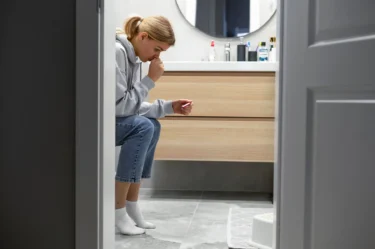
गर्म पानी से नहाना, बवासीर के कारण होने वाली जलन को शांत करने में मदद कर सकता है। सिटज़ बाथ इस्तेमाल करने का प्रयास करें। सिट्ज़ बाथ एक ऐसी विधि है जिसमें एक छोटे प्लास्टिक के टब का उपयोग किया जाता है जो टॉयलेट सीट पर फिट हो जाता है ताकि आप प्रभावित हिस्से को बस उसमें डुबो सकें। इस पानी में बीटाडीन का घोल या डॉक्टर द्वारा सुझाए गए अन्य एंटीसेप्टिक घोल का उपयोग किया जा सकता है।
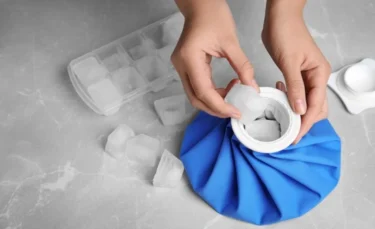
एक बार में कम से कम 15 मिनट तक सूजन से राहत पाने के लिए गुदा वाले हिस्से पर आइस पैक या कोल्ड कंप्रेस लगाएं। बड़े, दर्द करने वाले बवासीर के लिए ये कोल्ड कंप्रेस दर्द से निपटने का एक बेहद असरदार उपाय हो सकते हैं।
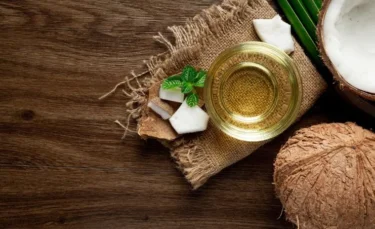
2008 में किए गए शोध के अनुसार, नारियल के तेल में मज़बूत एंटी-इंफ्लेमेटरी (सूजन मिटाने वाले) गुण होते हैं जो त्वचा लाल होने और सूजन को कम कर सकते हैं। इसमें एनाल्जेसिक (दर्द निवारक) गुण होते हैं जो बवासीर के कारण होने वाली परेशानी को कम करने में मदद कर सकते हैं। इसमें एंटीबैक्टीरियल (जीवाणु को मारने वाले) गुण भी होते हैं जो बवासीर के लक्षणों को कम करने में मदद करते हैं।

मल त्याग के बाद टॉयलेट पेपर इस्तेमाल करने से मौजूदा बवासीर में जलन हो सकती है। भीगे हुए वाइप्स, और जलन पैदा किए बिना आपको साफ रखने में मदद करते हैं। आप ऐसे वाइप्स का भी इस्तेमाल कर सकते हैं जिनमें एंटी-हेमरॉइड (बवासीर-रोधी) तत्व होते हैं, जैसे कि विच हेज़ल या एलोवेरा।

बवासीर के लक्षणों को असरदार तरीके से प्रबंधित करने के लिए घर पर व्यायाम करना एक शानदार उपाय हो सकता है। नियमित पेल्विक फ्लोर एक्सरसाइज़ करना बवासीर के लिए एक लॉन्ग-टर्म सॉल्युशन साबित हो सकता है। अपनी पेल्विक फ्लोर की माँसपेशियों को मज़बूत करने से, बिना ज़्यादा दबाव डाले अपनी आंत को खाली करने में मदद मिल सकती है।
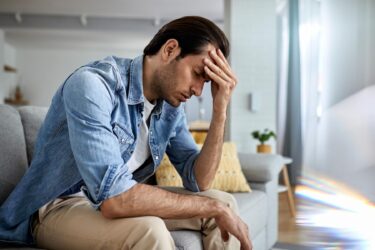
आराम करने और तनाव को असरदार तरीके से प्रबंधित करने के लिए एक कड़ा प्रयास करने से आंतों को अच्छी आदतें अपनाने में मदद मिलती है। रात में भरपूर नींद लेने से भी पाचन स्वास्थ्य अच्छा बनाए रखने में मदद मिलती है। ऐसा होने पर, आँतों से मल भी आसानी से होकर जा पाता है।

कहने की ज़रूरत नहीं है, लेकिन भरपूर पानी और फलों के रस जैसे अन्य स्वस्थ तरल पीने से आपकी आंत कम शुष्क होती है। जब आपका शरीर अच्छी तरह से हाइड्रेटेड (पानी की कमी न होना) होता है, तो आपका पाचन स्वास्थ्य बेहतर होने लगता है जिससे आपको मल त्याग के दौरान दबाव कम डालना पड़ता है।

भरपूर मात्रा में अघुलनशील और साथ ही घुलनशील फाइबर वाला संतुलित आहार लेने से आपको नियमित रूप से मलत्याग करने में मदद मिलेगी। अघुलनशील फाइबर आपके मल का वज़न बढ़ाता है, जिससे आपको मल त्यागने के दौरान ज़ोर कम लगाना पड़ता है। फाइबर को आंतों को स्वस्थ रखने में मदद करने के लिए भी जाना जाता है।
Read in English: 8 Best Home Remedies For Piles
ऊपर बताए गए बवासीर के लक्षणों में से कोई भी लक्षण दिखाई देने पर आपको बिना देरी किए डॉक्टर की सलाह लेनी चाहिए। ये लक्षण कोलोरेक्टल कैंसर जैसी अन्य गंभीर स्थितियों में आम हैं। इसलिए, एक डॉक्टर से इनकी जल्दी पहचान कराना ज़रूरी है। अपने डॉक्टर को सूचित करें अगर- :
बहुत सारे तरल पदार्थ पीना और फाइबर युक्त आहार लेना, खुजली और दर्द को शांत करने के लिए कुनकुने पानी से नहाना, डॉक्टर द्वारा लिखे गए टॉपिकल ऑइंटमेंट लगाना, व्यायाम करना और नीचे वाले भागों को सूखा रखना, ये सभी बवासीर से तेज़ी से राहत पाने में आपकी मदद करने के लिए एक कैटेलिस्ट के तौर पर काम करेंगे। डॉक्टर से परामर्श करना और उनके बताए इलाज का पालन करना ज़रूरी है।
अगर आपको बवासीर के लक्षण दिखाई देने लगे हैं, तो घर और बाहर के खाने में दूध और पनीर जैसे डेयरी प्रोडक्ट, मैदा, प्रोसेस्ड मीट, तला हुआ भोजन, मसालेदार खाद्य पदार्थ और लाल मांस के इस्तेमाल से बचना चाहिए। कहने का मतलब यह है, कि ऐसे भोजन से बचना चाहिए जो सूजन और कब्ज़ की संभावना को बढ़ाते हैं।
आपके रोग के कारणों को ध्यान में रखते हुए, आपके डॉक्टर आपकी स्थिति के आधार पर बवासीर के लिए सबसे सही दवाएं आपको लिखकर देंगे। इसमें सूजी हुई नसों को सिकोड़ने के लिए कुछ दवाएं, कुछ दर्द निवारक और कब्ज़ जैसी पाचन संबंधी समस्याओं का प्रबंधन करने के लिए दवाएं शामिल हो सकती हैं।
हां, बवासीर में दर्द और खुजली दोनों हो सकती हैं। बवासीर, गुदा और मलाशय के निचले हिस्से में सूजी हुई और फूली हुई नसें होती हैं। पारंपरिक तौर पर, बवासीर की समस्या शौचालय में लंबे समय तक बैठे रहने के साथ-साथ मल त्याग के दौरान ज़ोर लगाने के साथ जुड़ी हुई है। यह गर्भावस्था के दौरान भी आम है और आमतौर पर बच्चे के जन्म के बाद ठीक हो जाती है।
बवासीर के कीड़े आमतौर पर शिरा या रक्त में स्थानीय बदलाव के कारण उत्पन्न होते हैं, जैसे कि लंबे समय तक बैठे रहना, अधिक वजन, पेट में दबाव, या प्रेगनेंसी के दौरान बढ़ती हुई रक्त संचार। इन कारकों के कारण, गुदा क्षेत्र में रक्त की नसें सूज जाती हैं और उनमें से एक नस या गुदा में विकसित होने वाले कीड़े की शुरुआत होती है।
वासीर या पाइल्स (Piles) गुदा के आसपास की नसों में सूजन या फूलने की एक स्थिति है जिसमें गुदा के चारों ओर मस्से बन जाते हैं। यह आमतौर पर खून के साथ मस्से, खुजली, दर्द और बहुत ही पीड़ादायक होता है।
बवासीर, या हेमोराइड्स, जब गुदा क्षेत्र के आसपास की नसों में सूजन या विस्तार होता है, तो होती है। यह सामान्यतः गलत खान-पान, अपच, पेट में दबाव, या गर्भावस्था के दौरान बढ़ी हुई रक्त संचार के कारण हो सकती है। इसके अलावा, लंबे समय तक बैठे रहने, भारी भार को उठाने, या अत्यधिक दिखावा भी इसका कारण बन सकता है।
बवासीर, या हेमोराइड्स, गुदा क्षेत्र में नसों के सूजन या विस्तार के कारण हो सकता है। यह अक्सर अधिक बैठाव, कठिन पेट, अपच, गर्भावस्था, या वयस्कता के साथ जुड़ा होता है। जिम्मेदार आहार, सही व्यायाम, और नियमित बॉवल मूवमेंट इसे प्रबंधित करने में मदद कर सकते हैं।
बवासीर में गर्म पानी पीना सुझावित होता है। गर्म पानी सूजन को कम करने में मदद करता है और आराम प्रदान कर सकता है। गर्म पानी के सितले या गरम इस्त्रों का उपयोग बवासीर के लक्षणों को कम करने और उपचार करने में मदद कर सकता है।
बवासीर कई प्रकार का होता है, जैसे आंतरिक, बाह्य, और अन्य, जो उनके लक्षणों और स्थिति की गंभीरता के आधार पर भिन्न होते हैं।
बवासीर में दूध पीने से आमतौर पर कोई खास परेशानी नहीं होती है, लेकिन यदि किसी व्यक्ति को दूध से संबंधित कोई अलर्जी या अन्य संबंधित समस्या हो, तो वह अपने डॉक्टर से परामर्श करें।
बवासीर को 100% ठीक करना संभव है, लेकिन इसके लिए सही उपचार, संतुलित आहार और स्वस्थ जीवनशैली की आवश्यकता होती है। इसके लिए डॉक्टर की सलाह और उनके द्वारा सुझाए गए उपायों का पालन करना आवश्यक है।
हां, बवासीर वजन कमी का कारण हो सकता है। बवासीर के लक्षणों में पेट के दर्द, कब्ज, और अपाच शामिल हो सकते हैं, जो खाने की अवधि और पोषण को प्रभावित कर सकते हैं, जिससे व्यक्ति का भोजन कम हो सकता है। इससे वजन कम होने का संभावना होता है।
बवासीर माहवारी पर असर नहीं डालता है, क्योंकि ये दोनों अलग-अलग समस्याओं का कारण होते हैं। माहवारी महिलाओं के गर्भाशय की स्वाभाविक प्रक्रिया है, जबकि बवासीर गुदा क्षेत्र की नसों के सूजन या विस्तार के कारण होता है।
हां, बवासीर कब्ज का एक सामान्य कारण हो सकता है। कब्ज के कारण आंतरिक दबाव बढ़ सकता है, जिससे गुदा क्षेत्र की नसें या वृद्धि हो सकती हैं। यह विशेष रूप से लोगों के लिए संभव है जो कई दिनों तक कठिनाई से मल त्यागने की स्थिति में होते हैं। इसलिए, कब्ज का उपचार करना बवासीर के प्रतिरोध को कम करने में मदद कर सकता है।
हां, बवासीर कई मामूली से लेकर गंभीर दर्द का कारण बन सकता है। गुदा क्षेत्र में सूजन या विस्तार के कारण यहाँ दर्द उत्पन्न हो सकता है जो पेट में असहनीयता या तनाव का कारण बन सकता है। इसके अलावा, बवासीर कब्ज या अपच के कारण भी हो सकता है जो पेट में दर्द का कारण बन सकता है।
Disclaimer: The information provided here is for educational/awareness purposes only and is not intended to be a substitute for medical treatment by a healthcare professional and should not be relied upon to diagnose or treat any medical condition. The reader should consult a registered medical practitioner to determine the appropriateness of the information and before consuming any medication. PharmEasy does not provide any guarantee or warranty (express or implied) regarding the accuracy, adequacy, completeness, legality, reliability or usefulness of the information; and disclaims any liability arising thereof.
Piles, also known as haemorrhoids, are vascular cushions of the anal canal that become pathologically enlarged, inflamed, or symptomatic. It can be internal and form within the rectum (usually painless) or external and protrude beyond the anus (painful, especially if thrombosed).
The first signs include painless rectal bleeding (fresh blood in stool or on toilet paper). External haemorrhoids or prolapsed internal haemorrhoids can cause pain/discomfort while sitting, walking, and performing other movements1,2.
An anal fistula is a tract connecting the anal canal or rectum to the perianal skin, with the external opening on the skin near the anus and the internal opening inside the anal canal. It commonly forms from a perianal abscess originating in an anal gland (cryptoglandular infection)3. However, not all fistula are due to an infection; there are other causes too.
| Different Factors | Piles | Fistula |
| Causes | Common causes include straining during bowel movements, chronic constipation, and severe diarrhoea. Obesity also contributes to increasing pressure in the rectal area. Pregnancy and childbirth further predispose individuals to hemorrhoids due to increased pelvic pressure and hormonal changes. Although heavy lifting can raise intra-abdominal pressure and worsen hemorrhoids, it is considered a less common risk factor compared to persistent constipation1,4. | Most anal fistulas arise as a natural progression from an anal gland infection leading to a perianal abscess, which then develops into a fistula. Other important causes include inflammatory bowel disease, particularly Crohn’s disease, and infections such as tuberculosis, which are more often associated with complex or atypical fistulas. Trauma, radiation therapy, or prior treatment for anal cancer may also contribute in some cases3,5. |
| Symptoms | Bright red bleeding after passing stools, itching around the anus, soreness, redness, swelling, or a lump that may protrude and sometimes needs to be pushed back in (mainly with large or thrombosed internal hemorrhoids). Other possible signs include a mucus discharge following bowel movements4. | Persistent pus or fluid discharge from an opening near the anus, swelling and pain that may come and go, and sometimes redness or fever. Anal pain is common, especially during bowel movements, and in women, a rectovaginal fistula may also cause the passage of stool or gas through the vagina3,5. |
| Diagnosis | Digital rectal examination (DRE) helps detect internal haemorrhoids, anal masses, strictures, and internal fistula openings, while also assessing sphincter tone, tenderness, and palpable tracts. Anoscopy or proctoscopy allows direct visualisation of the anal canal and distal rectum. Flexible sigmoidoscopy can evaluate up to the sigmoid colon, but not the full colon, for which colonoscopy is required1,6. | Diagnosis of an anal fistula is mainly clinical, based on a history of abscess and persistent discharge, and is confirmed with examination (digital rectal exam, probing, or anoscopy). MRI pelvis is the gold standard for mapping tracts, while endoanal ultrasound may also be used; colonoscopy is considered if Crohn’s disease or malignancy is suspected5. |
| Treatment options that can be advised by doctors | Conservative measures such as sitz baths help relieve discomfort, itching, and irritation, but are not considered medicinal treatments. Rubber band ligation is a procedure for Grade II–III internal haemorrhoids, where a band is placed at the base to cut off the blood supply, causing the haemorrhoid to shrink; it is not used for external haemorrhoids. Sclerotherapy involves injecting a sclerosant to induce fibrosis and reduce the size of Grade I–II internal haemorrhoids and is ineffective for external haemorrhoids. Haemorrhoidectomy is the surgical removal of excessive tissue, typically reserved for severe or symptomatic haemorrhoids causing persistent bleeding1,2. | Conservative measures such as sitz baths may provide symptomatic relief, while topical medicines (antibiotics, analgesics, or anti-inflammatories) can be used in selected cases. Standard fistulotomy involves surgically opening the fistula tract to allow drainage and healing by secondary intention, rather than removing its lining. Fibrin glue or collagen plugs are minimally invasive options that seal the tract to promote healing, though success rates vary. Seton placement is often used for complex or high fistulas, permitting controlled drainage and fibrosis while preserving sphincter function. The endorectal advancement flap technique uses a flap of rectal wall to cover the internal opening of the fistula. The LIFT (ligation of intersphincteric fistula tract) procedure is a sphincter-preserving surgery that involves identifying, ligating, and excising the intersphincteric tract in a single stage5,7. |
| Prevalence | Piles are very common in both genders. However, women are more prone to developing haemorrhoids than men8. | Anal fistulas commonly develop around the age of 40. It affects males more than females3. |
| Complications if left untreated- | Complications of haemorrhoids may include severe pain and ischemic necrosis, while infection is rare. Anaemia from chronic blood loss may also occur, especially with persistent bleeding. Strangulated haemorrhoids occur when an external or prolapsed internal haemorrhoid becomes trapped, leading to impaired blood flow9. | Complications of untreated or severe fistulas may include recurrence of the fistula or abscess, an increase in the length and number of fistula tracts, and faecal incontinence due to sphincter involvement. In some cases, sepsis can occur if the infection spreads throughout the body. Peritonitis may develop when an intestinal fistula causes inflammation or infection of the peritoneum. Long-standing, untreated fistulas also carry a small risk of malignant transformation within the fistula tract10,12. |
In simple terms Piles is a condition in which blood vessels swell up, whereas a fistula is marked by the development of a tunnel from the anus to surrounding skin.
Fissures, piles and fistula are often confused as being the same conditions in an individual. Fissures usually heal on their own within a couple of days or weeks. Piles and fistulas usually require medical or surgical intervention.
Dr. Ashish Bajaj, M.B.B.S., M.D. in Clinical Pharmacology and Toxicology
Piles and fistula are two distinct conditions. However, it is possible for you to get confused between the two and their symptoms. If you ignore the symptoms of piles, such as pain, itching in the anal area, blood in stools and the symptoms of fistula, such as blood and foul-smelling discharge, pain in the rectum, swelling in the anal area and visibility of a tunnel at the opening of the anus, both the conditions may worsen over time and cause other complications. Consult a doctor to learn more about the difference between piles and fistula and seek appropriate treatment. Never self-medicate, proper diagnosis of your condition is the first step towards living a pain-free life.
Disclaimer: The information provided here is for educational/awareness purposes only and is not intended to be a substitute for medical treatment by a healthcare professional and should not be relied upon to diagnose or treat any medical condition. The reader should consult a registered medical practitioner to determine the appropriateness of the information and before consuming any medication. PharmEasy does not provide any guarantee or warranty (express or implied) regarding the accuracy, adequacy, completeness, legality, reliability or usefulness of the information; and disclaims any liability arising thereof.
Links and product recommendations in the information provided here are advertisements of third-party products available on the website. PharmEasy does not make any representation on the accuracy or suitability of such products/services. Advertisements do not influence the editorial decisions or content. The information in this blog is subject to change without notice. The authors and administrators reserve the right to modify, add, or remove content without notification. It is your responsibility to review this disclaimer regularly for any changes.
Piles or hemorrhoids are a medical condition that causes the veins around your rectum and lower anus to swell1. Symptoms of piles include pain and discomfort during and after passing stools while sitting and standing up, painful lumps in and around the anus, and bloody stools.
Piles can be both internal and external. Internal piles cannot always be diagnosed during the external examination, however, they sometimes may swell out of the anus region as in the case of external hemorrhoids. Piles is a disease that is not exactly rare, however, the symptoms can sometimes be easily missed as they are not always detectable and obvious. With surgery, piles can be removed. However, if your condition is not severe, your doctor may recommend some medicines, lifestyle and dietary changes that will help you cope with the condition. This article will shed light on the types of food you should eat to deal with piles more effectively.
Piles are a rather painful condition that causes discomfort when you are sitting or even standing. Fortunately, several food items can help reduce the risk factors of piles (constipation, bloating and other digestive issues) from occurring in the first place:
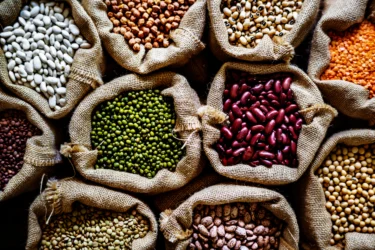
By making sure you are getting enough fibre in your diet daily, you can reduce the chances of piles flare-ups2. There are essentially two kinds of fibre that can be derived from food: soluble and insoluble. The soluble fibre forms a gel in your digestive tract and can be digested by friendly bacteria. On the other hand, insoluble fibre helps bulk up your stool3. Legumes include beans, lentils, peas, soybeans, peanuts and chickpeas that are loaded with both kinds of fibre but are especially rich in the soluble type. Lentils and other legumes can bulk up your stool, making it less likely that you have to strain when going to the bathroom.
Vegetables like cauliflower, Brussel sprouts, broccoli, bok choy, kale, arugula, tulips, cabbage and radishes are known for having an immense amount of insoluble fibre4. Cruciferous vegetables like these contain a plant chemical called glucosinolate that can easily be broken down by gut bacteria5, thus helping promote easy stool passing and helping reduce symptoms of a new flare-up of piles.
Turnips, beets, rutabagas, carrots, sweet potatoes and potatoes are root vegetables. They keep you full for a long time and are extremely nutritious. Besides, they are full of gut-friendly fibre. For example, cooked and cooled white potatoes contain a kind of carbohydrate known as resistant starch, which passes through your digestive tract undigested. Similar to soluble fibre, they help feed your gut bacteria and pass stool easily6.
Packed with vitamins like vitamin C and minerals, bell peppers are also a great option while adding fibre to your diet. A cup of mild bell peppers contains about 3.1 grams of fibre7. With a water content of about 93%, bell peppers are also very hydrating and help with clear stool passing.
Similar to legumes, whole grains are a nutritional powerhouse as they retain their germ, bran and endosperm, all of which are loaded with fibre content. Whole grains are known to be rich in insoluble fibre. The benefit of insoluble fibre is that, since it cannot be digested, it adds volume to your stool and helps you excrete with ease, with less pain and discomfort that comes with piles. Spelt, quinoa, barley, brown rice, oats, whole rye and corn are some beneficial whole grains. For example, you can prepare and consume oatmeal to reduce symptoms of piles. Oatmeal contains a special soluble fibre called beta-glucan, which benefits your gut microbiome by acting like a prebiotic, which in turn feeds the healthy gut bacteria and helps you excrete with ease8.
This vegetable brings life and colour to your plate, while also feeding you with an immense amount of fibre. There are various kinds of squash, like pumpkin, acorn squash, yellow squash, butternut squash and zucchini. Acorn squash has the highest amount of fibre, about 9 grams in every cup of this vegetable (205 grams). Sautéd, roasted or boiled squashes may help ward off any symptoms of piles.
They are an ideal addition to your diet to calm piles symptoms. Loaded with pectin and resistant starch, a single banana provides an average of 3 grams of fibre. The combination of pectin and resistant starch helps in clearing the stool easily.
Tomatoes contain loads of fibre and have good water content. It aids in easing symptoms of constipation by making you strain less while passing stools. Tomatoes contain a natural antioxidant called naringenin that, according to some scientists, has a laxative effect on constipation9.
Fruits like oranges, lemons and grapes are rich in vitamin C. The inner skin of these fruits, beneath the outer layer, has a lot of fibre. Citric fruits have ample water content that softens stools. Like tomatoes, citrus fruits also contain naringenin, a natural compound that has a laxative effect.
Based on the Dietary Guidelines for Americans, it is recommended that you consume an adequate amount of dietary fiber for optimal health. For a 2,000-calorie diet, this means aiming for around 28 grams of fiber per day2, 10.
Dr. Rajeev Singh, BAMS
Also Read: Potassium-Rich Fruits to Boost Your Potassium Levels Naturally
All food items that are low in fibre should be avoided. Some of them are as follows:
Also Read: 17 Protein-Rich Foods For a Healthy Life
Thus, with proper care, good food, discomfort, pain and inflammation caused by piles can be curbed and reduced while avoiding controversial food items. Depending on the severity of your condition, along with medication and a good diet, you should be able to overcome your condition in a few weeks to a few months.
Did you know that hemorrhoids are a common condition affecting both men and women? Surprisingly, more than half of adults over the age of 50 experience hemorrhoids at some point in their lives.
Dr. Siddharth Gupta, B.A.M.S, M.D (Ayu)
Also Read: Food Choices for Hernia: What to Eat and Avoid
In general, less severe piles conditions go away in a few days on their own with a well-balanced diet or with over-the-counter drugs. Larger haemorrhoids, particularly ones that cause a lot of pain, swelling and itchiness, will not go away on their own and may require treatment from a doctor to heal, like medication or may have to be surgically removed.
The consumption of eggs improves the movement of the intestines and helps in making the stool soft. Eating an egg daily gets rid of constipation and other stomach-related problems. Not only this, eggs contain a lot of protein and fat, which is beneficial for patients. Therefore, you can consume eggs in moderation if you have piles.
Papain present in raw papayas is beneficial to combat several health problems like excess of unhealthy mucus in the stomach, overcoming the deficiency of gastric juice, dyspepsia (indigestion) and intestinal irritation. The ripe fruit, if eaten regularly, corrects constipation, bleeding piles and chronic diarrhoea11.
Disclaimer: The information provided here is for educational/awareness purposes only and is not intended to be a substitute for medical treatment by a healthcare professional and should not be relied upon to diagnose or treat any medical condition. The reader should consult a registered medical practitioner to determine the appropriateness of the information and before consuming any medication. PharmEasy does not provide any guarantee or warranty (express or implied) regarding the accuracy, adequacy, completeness, legality, reliability or usefulness of the information; and disclaims any liability arising thereof.